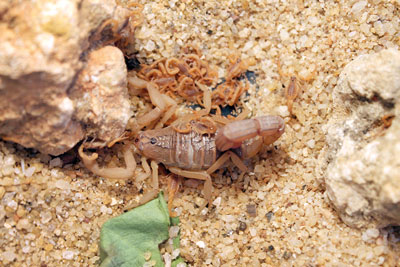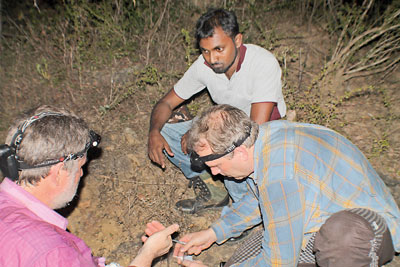News
It’s scorpion season – but don’t scream and squash them

The female red scorpion was found in Jaffna under the pillow of a sting victim and sent to Peradeniya University for identification and has now given birth inside the lab to several young ones
Another rainy season has begun, bringing that unwelcome visitor, the scorpion. Known for the venomous sting at the tip of its tail, scorpions cause panic and the immediate reaction is to squash and kill them – but wait, say researchers at the University of Peradeniya – “The scorpion you kill can be a species that is rare and threatened”.
Researcher Sanjeewa Jayaratne said a small scorpion found in his home last year was found to be a species new to science and endemic to Sri Lanka. “It was found inside my house. The little creature could have fallen from the wooden roof. There could be more such unidentified scorpions in other parts of Sri Lanka,” Mr. Jayaratne said.
Four scorpions new to science were discovered in an islandwide survey last year carried out by a team led by the University of Peradeniya’s Professor Kithsiri Ranawana along with a world authority on scorpions, Frantisek Kovarik, Mr. Jayaratne told The Rufford In-country Conference of Sri Lanka recently held in Kandy by the Bio Conservation Society. The Rufford Foundation is a British charity that funds nature conservation projects in the developing world.
The new finds bring to 18 the number of scorpions in this country, 14 of them endemic species.
The research team found the deadly Indian red scorpion (Hottentotta tamulus) – which arrived in Jaffna accidentally with the Indian Peace-Keeping Forces during the civil war – has adapted well to the arid conditions of the peninsula and is found in Achchuweli, Karainagar, Palali, Jaffna and Kankesanthurai.
While no deaths from scorpion bites were reported last year, 50-60 patients had to seek treatment for red scorpion stings, Professor S.A.M. Kularatne of the University of Peradeniya’s Medical Faculty said.
Only the Indian red scorpion’s venom causes severe illness: other scorpions have a mild venom and stings are very rare as many species live in the bark of trees, not in human dwellings.
The scorpion species found on floor of Mr.Jayaratne’s home was named Charmus saradieli after the famous outlaw Saradiel who lived in Uthuwankanda two centuries ago. Two other newly-found scorpions were named after Mr. Jayaratne and Prof. Ranawana –Reddyanus jayarathnei and Reddyanus ranawanai respectively. The fourth species is named Reddyanus ceylonensis.
Studying scorpions is not easy as they are nocturnal creatures. “We travel to selected research sites during the daytime and go into the field around 10pm to look for scorpions until day breaks,” a researcher said.
Larger scorpion species live in burrows and under rocks on the ground while smaller ones prefer to live in the bark of trees and are well camouflaged.
Researchers use a special UV light to spot the stealthy creature: it becomes illuminated in bright luminous blue when its exo-skeleton captures the light, Mr.Jayarathe said.
Most scorpions in Sri Lanka have a restricted range but two are common in many areas, including the world’s largest, Heterometrus swammerdami, which is nine inches (23cm) long.
Mr. Jayaratne has been stung by scorpions several times and says using local first aid – rubbing a red onion and lime mixture around the sting – and taking paracetamol relieved the pain within hours. People react differently to venom, however, so it is important to obtain medical attention if the victim shows great discomfort. In areas inhabited by the deadly red scorpion one should not take chances but seek medical help as soon as possible, Mr. Jayaratne advised.

Field observations conducted at night
| First aid for scorpion bite A person stung by a scorpion would feel a painful, tingling, burning or numb sensation at the sting site. Most scorpion bites do not require much attention but If you are bitten in areas where the Indian red scorpion is found, or can positively identify the species, seek medical assistance immediately. Wash the sting with soap and water and remove all jewellery in case it restricts circulation if there is swelling of tissue e.g. if there is a ring on a finger that starts to swell up. Apply cool compresses on the sting area, usually 10 minutes on and 10 minutes off. Do not cut into the wound or apply suction. If the victim is five years of age or younger, seek evaluation by a medical caregiver. Give a painkiller to relieve pain, but avoid aspirin and ibuprofen (Advil, Motrin) because they could contribute to other problems. If symptoms increase in severity, go to a hospital emergency department. - http://www.emedicinehealth.com/ |

